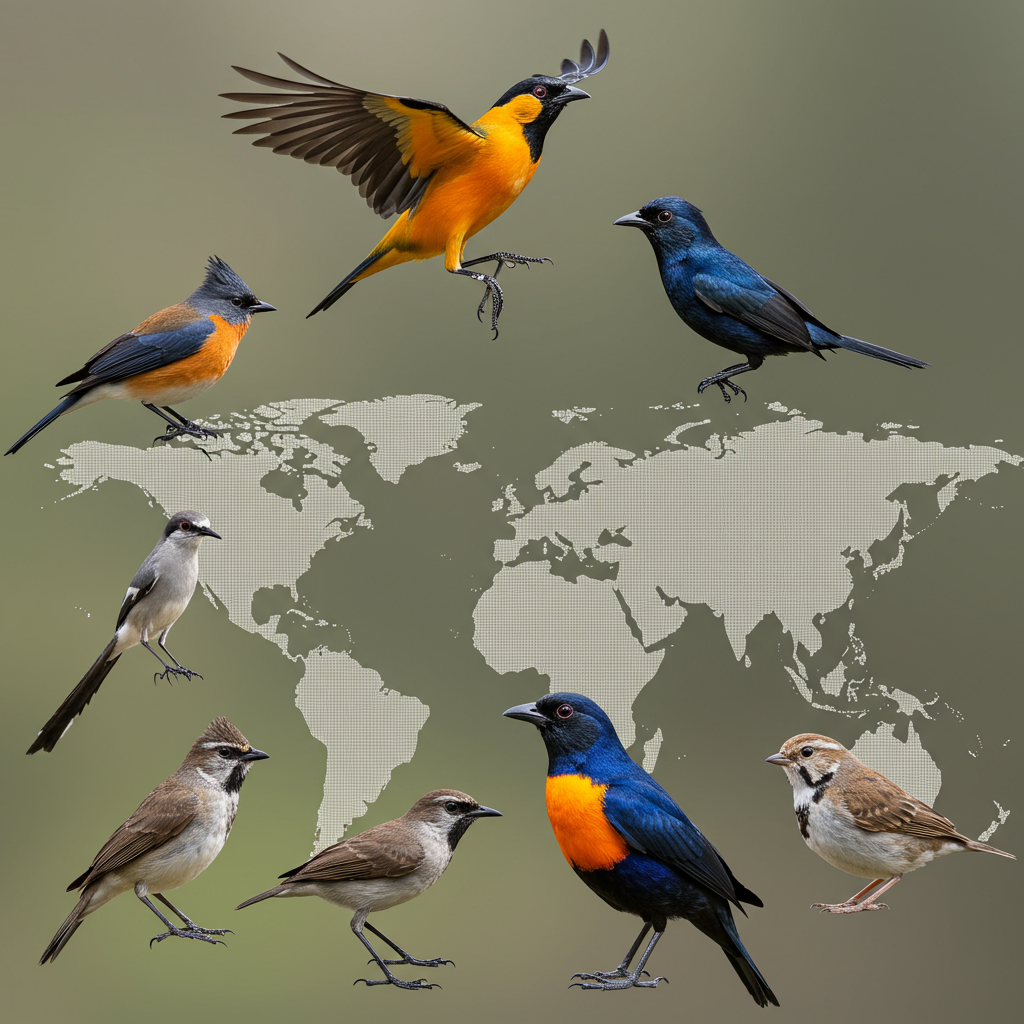Imagine a hidden language, understood across continents by diverse species separated by millions of years of evolution. Recent groundbreaking research has unveiled just such a phenomenon: a remarkably consistent bird alarm call used globally to warn against a specific and insidious threat – brood parasites. This discovery not only reshapes our understanding of animal communication but also offers profound new insights into the very origins of language. It’s a compelling testament to nature’s intricate strategies for survival, demonstrating how birds have developed a sophisticated, cross-species warning system to protect their young from cunning intruders like cuckoos and parasitic finches.
Decoding Nature’s Shared Warning Signal
The journey to uncover this global avian lexicon began with keen observations in Australia. Researchers, including William Feeney from Griffith University and James Kennerley of the Cornell Lab of Ornithology, had previously documented the superb fairy-wren’s unique alarm call. This specific vocalization rallied other wrens to mob and attack cuckoos, notorious brood parasites that lay their eggs in host nests, tricking unsuspecting birds into raising their offspring. What quickly became apparent, however, was that other local bird species were not only responding to the fairy-wren’s call but were also producing strikingly similar sounds themselves.
Intrigued by these initial findings, the scientists broadened their inquiry. Discussions with collaborators in vastly different regions, from China and India to Sweden, revealed an astonishing pattern: birds in these distant lands were exhibiting identical alarm behaviors and vocalizations when confronted by cuckoos. This suggested something far grander than localized mimicry; it hinted at a potentially universal language of alarm.
Unveiling a Cross-Continental Vocalization
To systematically investigate this global consistency, the research team delved into online wildlife media databases, a modern tool for bioacoustics research. Their meticulous search identified 21 bird species, spanning continents and millions of years of evolutionary divergence, all emitting this distinct “whining” vocalization in the presence of brood parasites. These species were often distantly related, with their last common ancestor dating back over 50 million years, yet they had independently converged on this specific sound.
Consider the vivid examples: the Australian superb fairy-wren vehemently responding to a shining bronze-cuckoo, or the tawny-flanked prinia in Zambia reacting to a cuckoo finch. Despite their vast geographical separation and distinct evolutionary paths, the core message of their bird alarm calls was unmistakably the same. This suggested that the call served a crucial, widely understood purpose, extending far beyond the boundaries of any single species.
The Purpose: Cooperation Against a Unique Threat
The primary function of any vocalization is to convey information. The researchers initially considered if this unique call facilitated cooperation within a species. However, their analysis of a global database of brood parasites and hosts revealed no correlation between the call’s production and increased within-species cooperativeness. Instead, a compelling pattern emerged: species that produced this specific avian warning were more prevalent in regions with a higher density of brood parasites and their hosts.
This crucial finding pointed to a different conclusion: the call’s main purpose is to enable cooperation across different species that are all targeted by brood parasites. Brood parasitism represents a unique threat. Unlike a predator, which directly endangers the adult bird, a brood parasite primarily threatens the host’s offspring. A baby cuckoo, for instance, typically heaves the host’s eggs or chicks out of the nest, claiming all parental effort for itself. This high cost of brood parasitism has driven the evolution of sophisticated defense mechanisms, including this shared cross-species signal.
Scientific Validation Through Field Experiments
To empirically confirm the specificity and universality of these bird alarm calls, controlled experiments were conducted. In Australia, researchers presented superb fairy-wrens and white-browed scrubwrens with taxidermied models. When confronted with a cuckoo model, the birds consistently produced the distinctive alarm call and actively attempted to attack the perceived threat. Crucially, when presented with other models, such as predators, this specific call was rarely, if ever, emitted. This confirmed the call’s highly specialized nature, targeting brood parasites exclusively.
Further playback experiments solidified these findings. When recordings of the call were played, both fairy-wrens and scrubwrens responded strongly and predictably, indicating their understanding and readiness to act. Perhaps the most striking evidence of the call’s “universal word” status came from cross-continental playbacks. Recordings of Australian bird calls elicited the same defensive response from birds in China, and vice-versa. This powerful result confirmed that disparate species from around the world inherently grasp the specific information conveyed by this vocalization: “a brood parasite is here.” Rose Thorogood from the University of Helsinki noted that this might stem from an acoustic feature inherently effective at deterring parasites, rather than a deep ancestral connection.
Bioacoustics: Eavesdropping on Nature’s Symphony
This discovery was made possible through the field of bioacoustics, which involves listening to and analyzing the sounds of nature. As highlighted by researchers like Connor Wood from the Cornell Lab of Ornithology, bioacoustic data provides a uniquely broad and comprehensive perspective on ecosystem dynamics. By “eavesdropping on nature’s symphony” through extensive audio recordings, scientists can detect subtle shifts in animal vocalizations and population patterns. While the primary focus of the current study was bird communication, the broader application of bioacoustics also extends to monitoring environmental health. For instance, studies have revealed a “pervasive loss of acoustic diversity” in soundscapes correlating with species decline due to habitat loss and climate change, demonstrating the critical role of sound in understanding our planet’s well-being. This powerful methodology allows researchers to unlock the hidden languages of wildlife and gain unprecedented insights into their behaviors and interactions.
A Stepping Stone Towards Language Evolution
Beyond its immediate implications for avian ecology, this research offers a profound contribution to our understanding of language evolution. Charles Darwin, in his 1871 work The Descent of Man, speculated that spoken language might have emerged from the imitation and modification of instinctive sounds. This new study provides compelling evidence that supports Darwin’s long-held hypothesis.
The scientists discovered a remarkable duality in how birds utilize this universal call: while the response to hearing the alarm call is instinctive, the production of the call itself is learned. Birds unexposed to cuckoos do not initially produce the call, but they learn to do so after observing other birds using it in the presence of a parasite. This unique combination of an instinctive response and learned production makes this the first example of an animal vocalization across species that incorporates both components. It represents a crucial “midpoint” or “first stepping stone” between the simple, innate vocalizations common in most animal communication systems and the complex, referential nature of human language.
Rob Magrath of the Australian National University reinforces this view, suggesting that such referential calls—which convey information about external objects or events rather than just internal states—are analogous to human words. This positions animal communication and human language not as entirely separate entities, but as existing on a continuum, challenging the notion that complex language is an exclusively human attribute.
Frequently Asked Questions
What unique features define the universal bird alarm call against brood parasites?
This specific bird alarm call is unique for several reasons. Firstly, it’s a structurally similar “whining” vocalization used by over 20 diverse bird species across various continents, despite their last common ancestor being over 50 million years ago. Secondly, it is highly specific, almost exclusively emitted in the presence of brood parasites like cuckoos, not general predators. Most profoundly, it exhibits a fascinating duality: the response to hearing the call is instinctive, but the production of the call itself is learned through observation. This combination makes it a unique example of a proto-language in the animal kingdom.
How do scientists use bioacoustics to uncover global bird communication patterns?
Scientists leverage bioacoustics by deploying vast networks of audio recorders and hydrophones across diverse landscapes and ecosystems. This allows them to “eavesdrop on nature’s symphony,” capturing and analyzing the vocalizations of wildlife. For this particular study, researchers consulted online wildlife media databases, which compile acoustic data, to identify common bird alarm calls used against brood parasites across different regions like Australia, China, India, and Sweden. Field experiments, involving playback of recordings to birds, further validated the cross-continental understanding of these calls, demonstrating the power of acoustic monitoring in understanding intricate animal communication.
What does this discovery imply for our understanding of human language origins?
This discovery offers profound insights into language evolution, supporting Charles Darwin’s theory that spoken language might have emerged from the adaptation of instinctive sounds. The birds’ universal alarm call, with its blend of an instinctive response and learned production, represents a crucial “stepping stone” between simple animal vocalizations and human language. It suggests that complex, referential communication, capable of conveying specific external information (like “a cuckoo is here”), is not exclusive to humans. This understanding challenges the perceived gap between animal communication and human language, viewing them instead as points on a developmental continuum.
Conclusion
The revelation of a universal bird alarm call to warn against brood parasites is a remarkable scientific achievement. It highlights the incredible adaptive capacity of nature and the intricate, often hidden, communication networks that sustain ecosystems. This study, led by researchers like William Feeney and his colleagues, not only deepens our appreciation for animal intelligence and the complexities of avian life but also provides compelling evidence for a long-theorized link in the evolutionary chain of language. As we continue to decode these subtle cross-species signals, we gain not only a better understanding of the animal kingdom but also a clearer reflection of the very foundations of human communication. The natural world, it seems, still holds countless secrets, waiting for us to listen closely.




